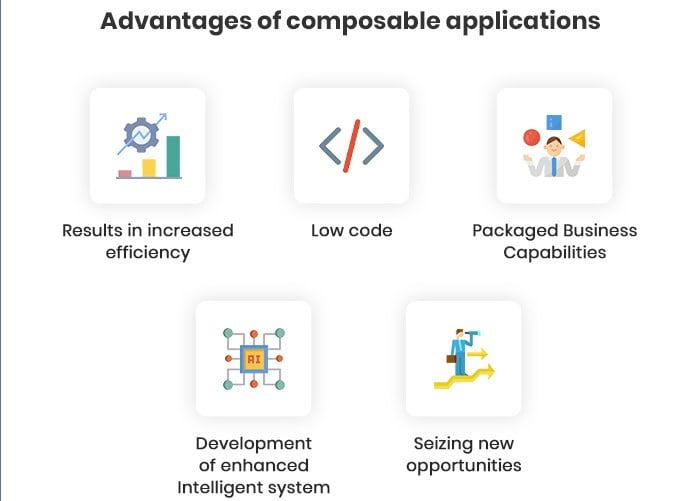What are composable applications?
Business-aligned, microservices-based apps that use a composable architecture are known as composable applications. Instead of developing a monolithic application from scratch, this composable application approach concentrates on reusing and combining services to rapidly and easily create new applications in response to business demands.
There are four essential parts that make up the architecture of composable application:
Services: These applications are made up of a number of well-defined, loosely connected services that may be merged and reused to make new ones.
Contracts: Each service is governed by a contract that outlines its abilities, inflows, outputs, and other key details.
Registry: A service registry maintains data on all offered services and associated agreements.
Orchestration: To put together new applications, an orchestration layer coordinates the execution of services.
How can they be used?
A novel approach to software development called composable applications enables better reuse and flexibility. Composable programs enable you to use pre-existing components and combine them in novel ways, as opposed to having to construct everything from the ground up. New applications may now be made considerably more quickly and with fewer effort thanks to this. Composable apps are also more maintainable and scalable than conventional monolithic applications. Composable applications are growing in popularity for a variety of use cases as a result of these factors. The following are some scenarios in which composable apps can be used:
- The creation of web applications
- Creation of mobile applications
- Develop IoT applications
- Creation of blockchain applications
- Creation of cloud-based applications
- Applications for artificial intelligence and machine learning
What are some benefits of Composable Applications?

As a technique to construct huge systems from smaller, reusable components, composable applications are gaining popularity. This strategy has various advantages, including the following:
Increased adaptability: Modifying or adding functionality to composable apps is simple and doesn’t need rewriting the entire application. When it comes to maintenance and updates, this might be a significant advantage.
Enhanced efficiency: Because they reuse pre-existing components rather than writing duplicate code, composable services can be more effective than static ones. Saving time and money are potential results of this.
Greater modularity: Composable apps make it simple to split an application up into smaller, easier-to-manage sections. Debugging and development could become easier and more efficient as a result.
Low Code: Low code is the main benefit that any firm can obtain from composable programs. Applications and architecture that can be composed typically have low code, which enables organizations to address complicated challenges that include multiple technologies.
Drawbacks of Composable application
Users can build unique applications by integrating various software components with composable apps, a sort of software. Composable apps may have several limitations, despite the fact that it might be a terrific method to develop original applications. First, Compared to conventional monolithic systems, composable applications may be more challenging to create and debug. This is due to the need for individual component testing and debugging as well as the possibility of unpredictable interactions between components.
Composable apps may also be more challenging to manage and deploy than conventional programs. This is due to the requirement that each component is deployed independently and the careful management of component dependencies. Therefore, compared to conventional monolithic systems, composable applications may need more design and planning work.
How Composable application can be implemented?
Applications that may be assembled from smaller, independent parts are known as composable applications. Numerous advantages of this strategy include more adaptability, fewer dependencies, and easier testing and debugging. Composable programs, however, could be more challenging to implement than conventional monolithic structures. The requirement that each module is created to function independently of the others poses difficulty and may necessitate extensive planning in advance.
Additionally, maintaining communication across modules can be challenging, so it’s critical to make sure that data is properly synchronized. Composable apps are nevertheless well worth the trouble for many software development processes despite these difficulties because they provide numerous benefits.
Are they right for every situation?
These programs can be a fantastic method to increase the modularity and maintainability of software. Composable applications, however, are not appropriate in all circumstances. Before choosing to employ this strategy, you should be aware of several trade-offs.
Composable applications may have drawbacks, including the possibility of increased complexity. It can be more challenging to remember how everything goes together when you are working with more little bits. Debugging and troubleshooting could become more difficult as a result. Composable apps could also not function as well as conventional monolithic applications. This is due to the higher administrative costs involved in supervising and coordinating all of the smaller parts.
Composable apps have increased modularity and flexibility as advantages. The reuse of code and the addition of new features may be simplified by this method. Additionally, compared to monolithic programs, composable applications are typically simpler to test and deploy. Ultimately, your particular needs and requirements will determine whether or not configurable apps are the correct choice for you.
Conclusion
Applications that can be composed have various benefits, such as increased modularity and flexibility as well as simpler testing and deployment. But there are also costs associated with them, such as heightened complexity and identifying possible difficulties. Your unique demands and requirements will determine whether or not composable applications are the correct choice for you. If you choose to employ this strategy, it is crucial to thoroughly prepare and build your application upfront in order to prevent potential issues later on.
